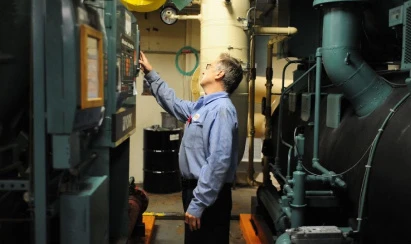New York City icon reaches for carbon neutrality
Tags
The Empire State Building has been an integral part of the NYC skyline since 1931. The 102-story art deco structure totaling 2.8 million gross square feet is heated by district steam.
Following a deep energy retrofit initiated in 2009, Empire State Realty Trust (ESRT) has taken a step further with ESB 2.0, a groundbreaking, comprehensive plan to bring the iconic building to net zero. Empire State Realty Trust and their team of consultants developed a phased roadmap for its entire commercial portfolio that strategically deploys energy conservation and decarbonization measures through 2035. ESRT will optimize existing systems, maximize energy recovery, and enable heat pump integration to decrease steam and electricity consumption.
By 2035, ESRT portfolio will target net zero through an 80% operational carbon reduction, achieved through a combination of energy efficiency measures, a renewable sourced grid, and a 20% offset with off-site clean energy generation and renewable energy certificates (RECs).

Project Highlights
Step 1
Step 1: Examine Current Conditions
A baseline assessment is key to understanding current systems and performance, then identifying conditions, requirements or events that will trigger a decarbonization effort. The assessment looks across technical systems, asset strategy and sectoral factors.
Building System Conditions
- Equipment nearing end-of-life
- Tenant load change
- Comfort improvements
- Resilience upgrades
- Efficiency improvements
Asset Conditions
- Tenant turnover/vacancy
- Carbon emissions limits
- Tenant sustainability demands
- Owner sustainability goals
Market Conditions
- Technology improves
- Market demand changes
- Market supply changes
- Policy changes
To establish a “business-as-usual” baseline scenario, the project team meticulously evaluated the current operational conditions and systems within the Empire State Building. This comprehensive review included:
- The building’s operating schedule
- Building and energy management systems
- Cooling, heating, and ventilation systems
- Lighting, plug loads, and tenant IT loads
- Domestic hot water systems
- The building envelope system
For a precise evaluation, the team analyzed the building’s utility data from the baseline year of 2019. This analysis aimed to dissect energy consumption, utility expenses, and resultant carbon emissions across different fuel types, including gas, steam, and electricity.
In addition to assessing the building’s physical baseline conditions, the team identified several key factors motivating the need for strategic decarbonization initiatives:
- The technical and economic imperative to align with municipal and state climate objectives set for 2024, 2030, 2035, and 2050
- Specifically relevant was the necessity to avoid penalties linked to Local Law 97 (LL97),
- Commitments to the electrical grid
- Upcoming major equipment replacements within the next decade
- Enhanced building resilience
- Existing limitations in cooling capacity
- In the short-term, the comparative advantage of district steam in reducing emissions over electricity, due to lower carbon emissions coefficient
To contextualize the project’s carbon reduction targets, the team layered essential carbon-related objectives onto the baseline scenario. These objectives encompassed the emission thresholds defined by LL97 for the periods 2024-2029, 2030-2035, and beyond 2035, along with a goal to slash emissions by 80% from the 2007 baseline. This strategic overlay clarified that although previous energy efficiency efforts had substantially cut emissions beneath the LL97 2024 benchmark, significant further action was required to fulfill the upcoming emission limits and the ambitious 80% reduction goal. Notably, reaching this 80% reduction will demand comprehensive measures beyond merely reducing or eliminating gas and steam usage; it will also necessitate a significant reduction in electrical energy consumption.
Step 2
Step 2: Design Resource Efficient Solutions
Effective engineering integrates measures for reducing energy load, recovering wasted heat, and moving towards partial or full electrification. This increases operational efficiencies, optimizes energy peaks, and avoids oversized heating systems, thus alleviating space constraints and minimizing the cost of retrofits to decarbonize the building over time.
Existing Conditions
This diagram illustrates the building prior to the initiation of Strategic Decarbonization planning by the owners and their teams.
Click through the measures under “Building After” to understand the components of the building’s energy transition.
Sequence of Measures
2022
2023
2024
Building System Affected
- heating
- cooling
- ventilation
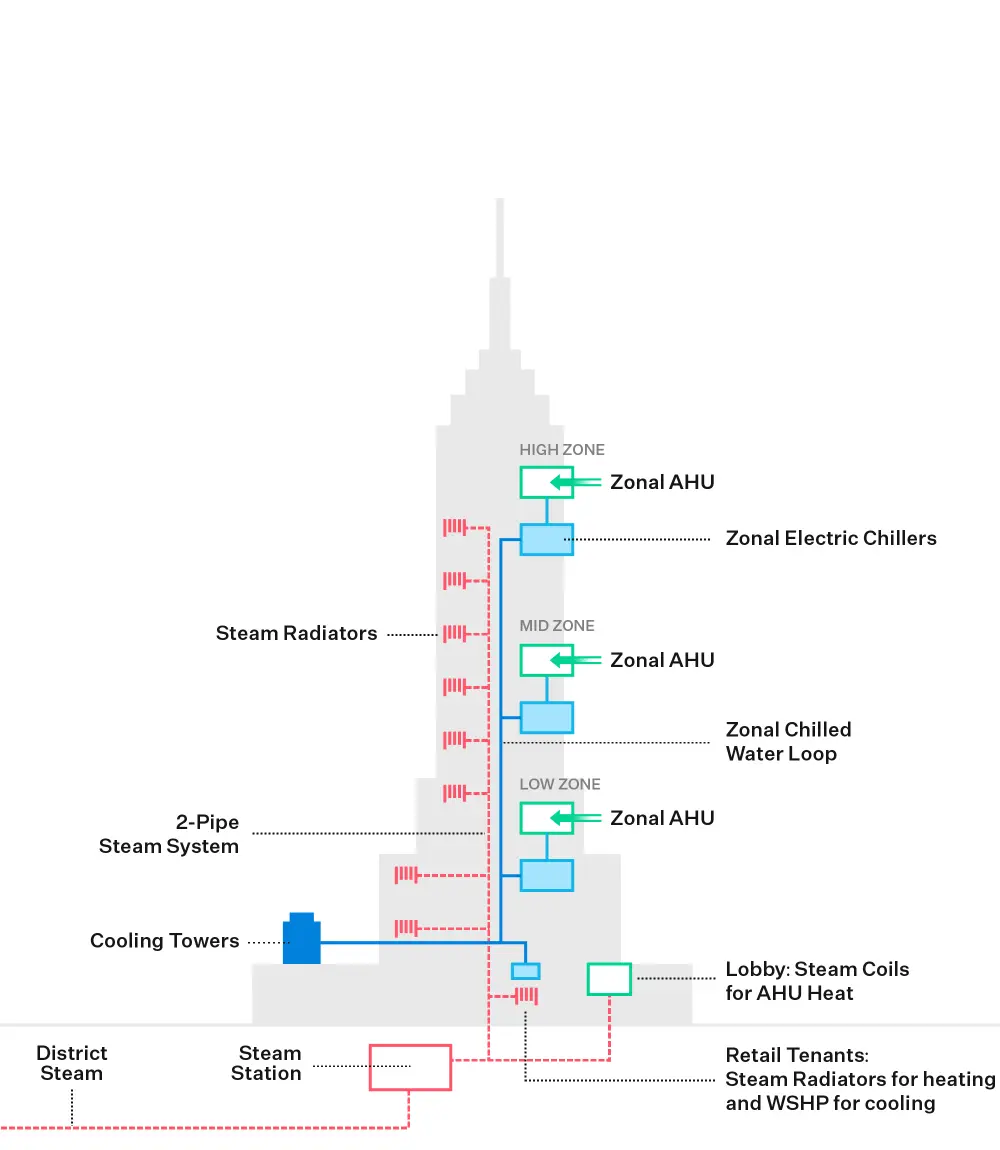
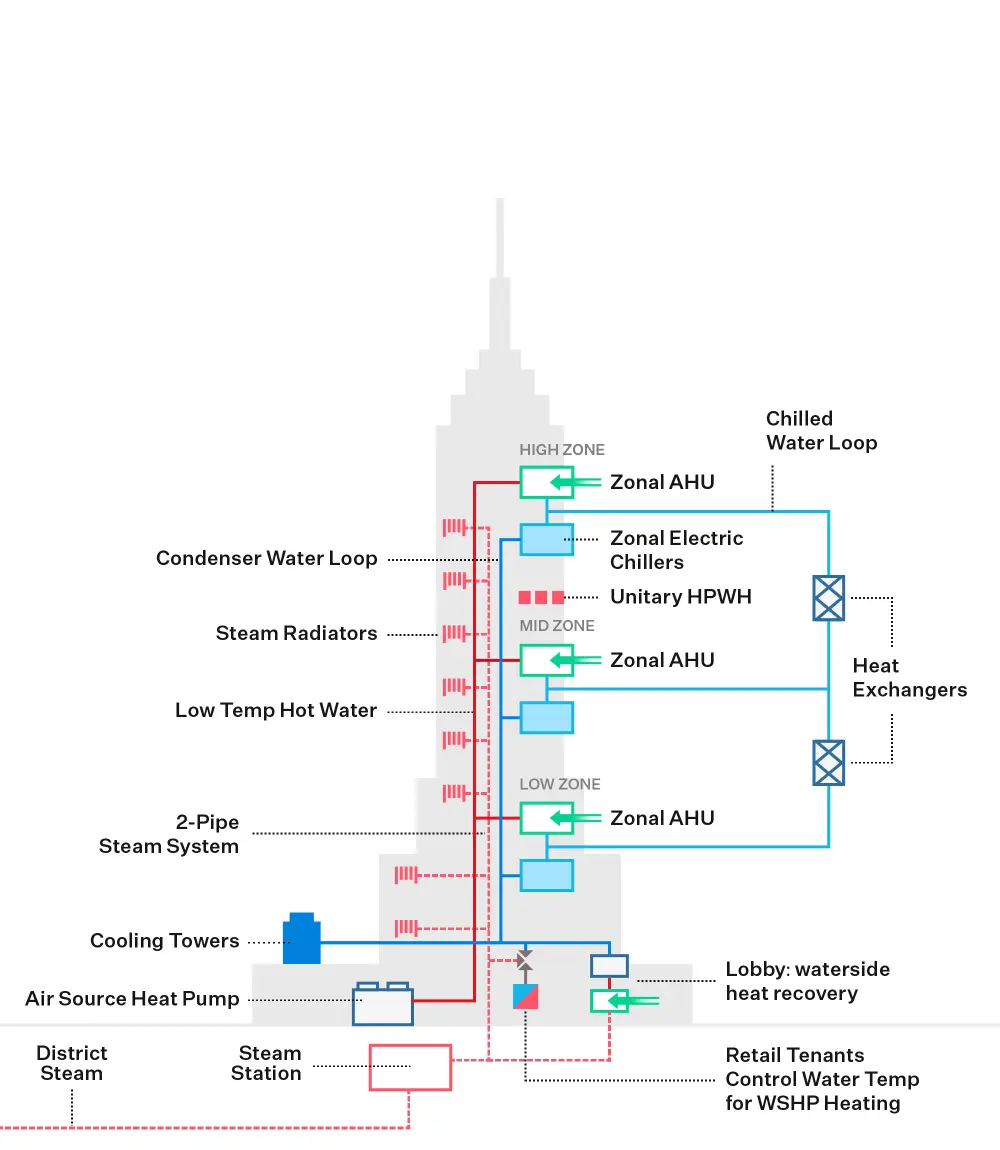
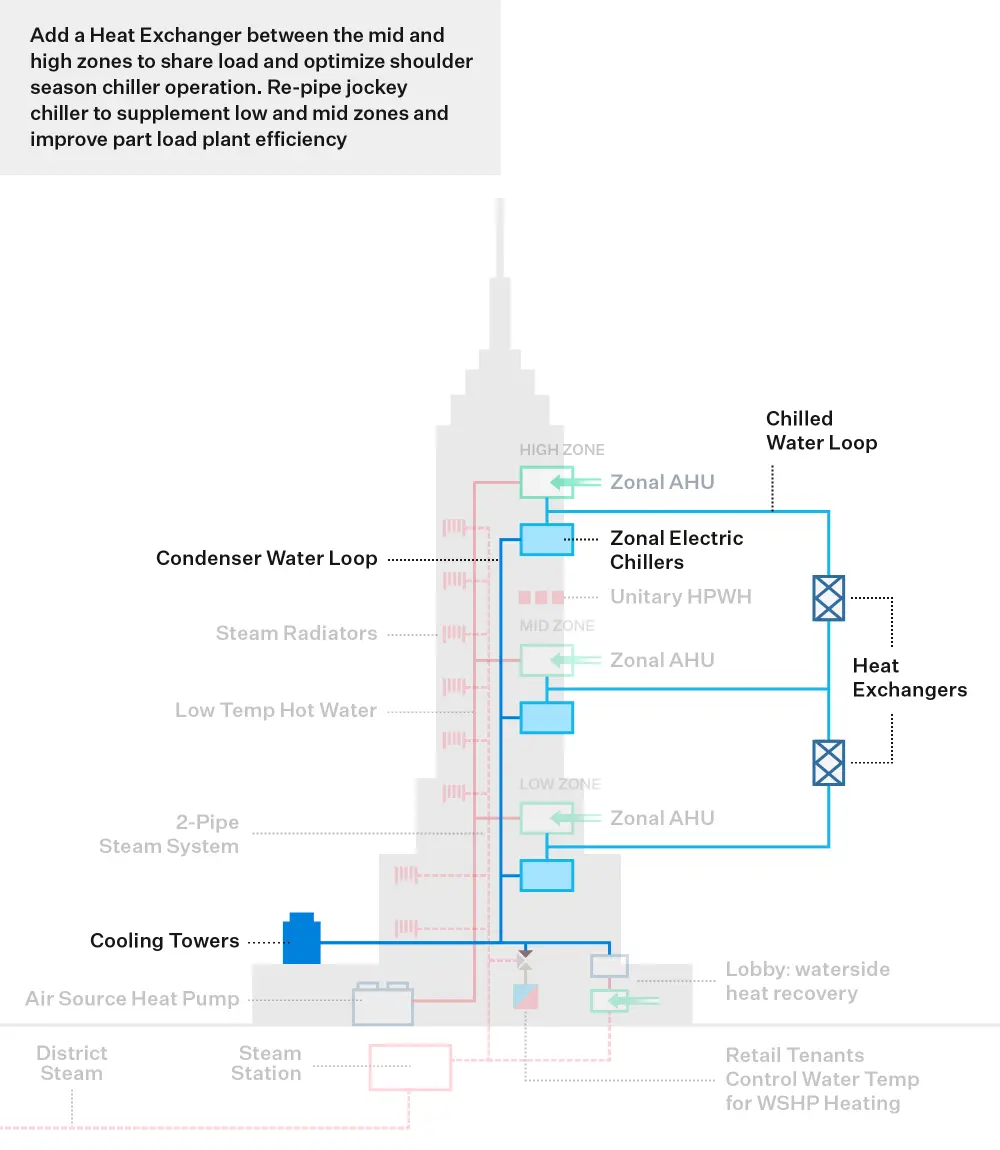
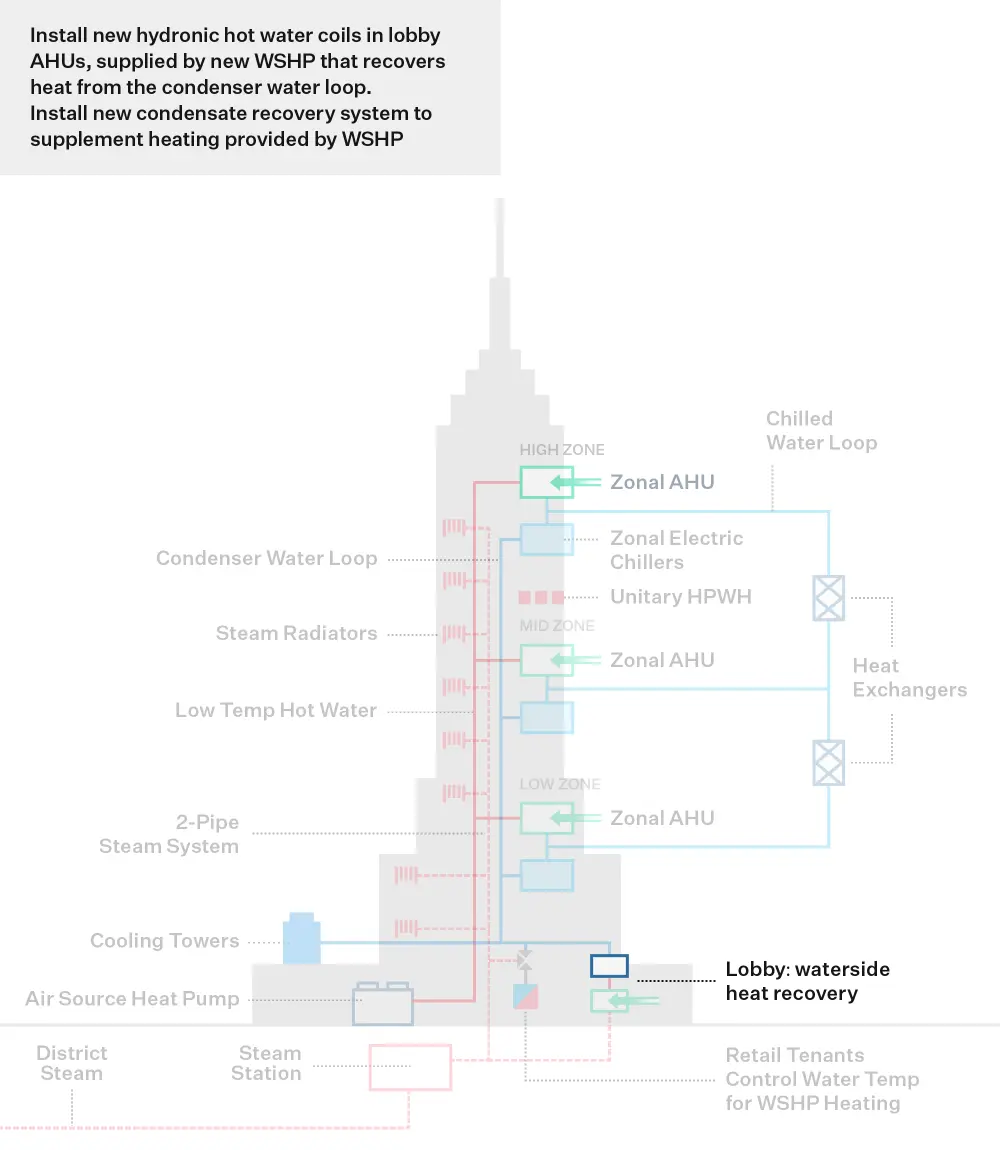
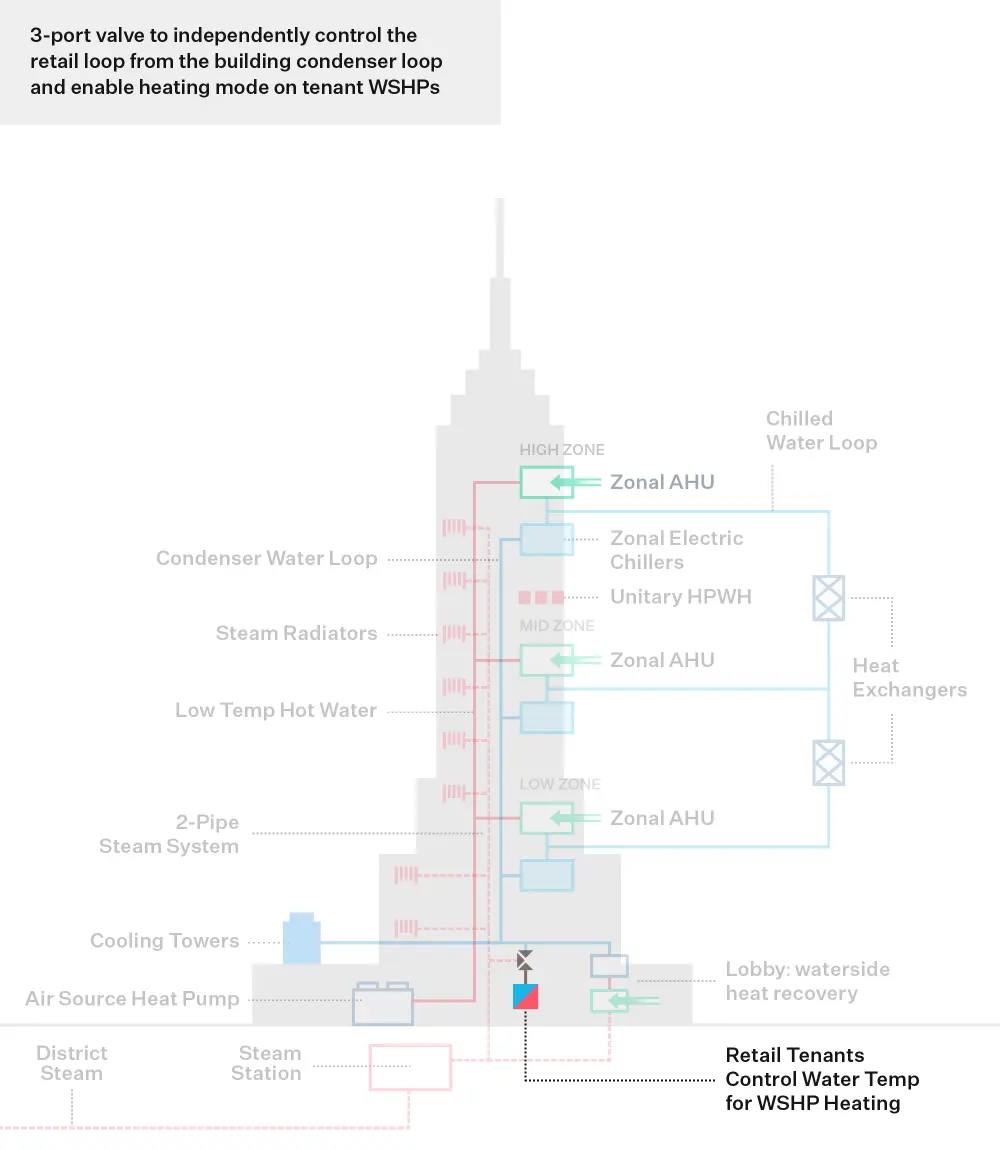
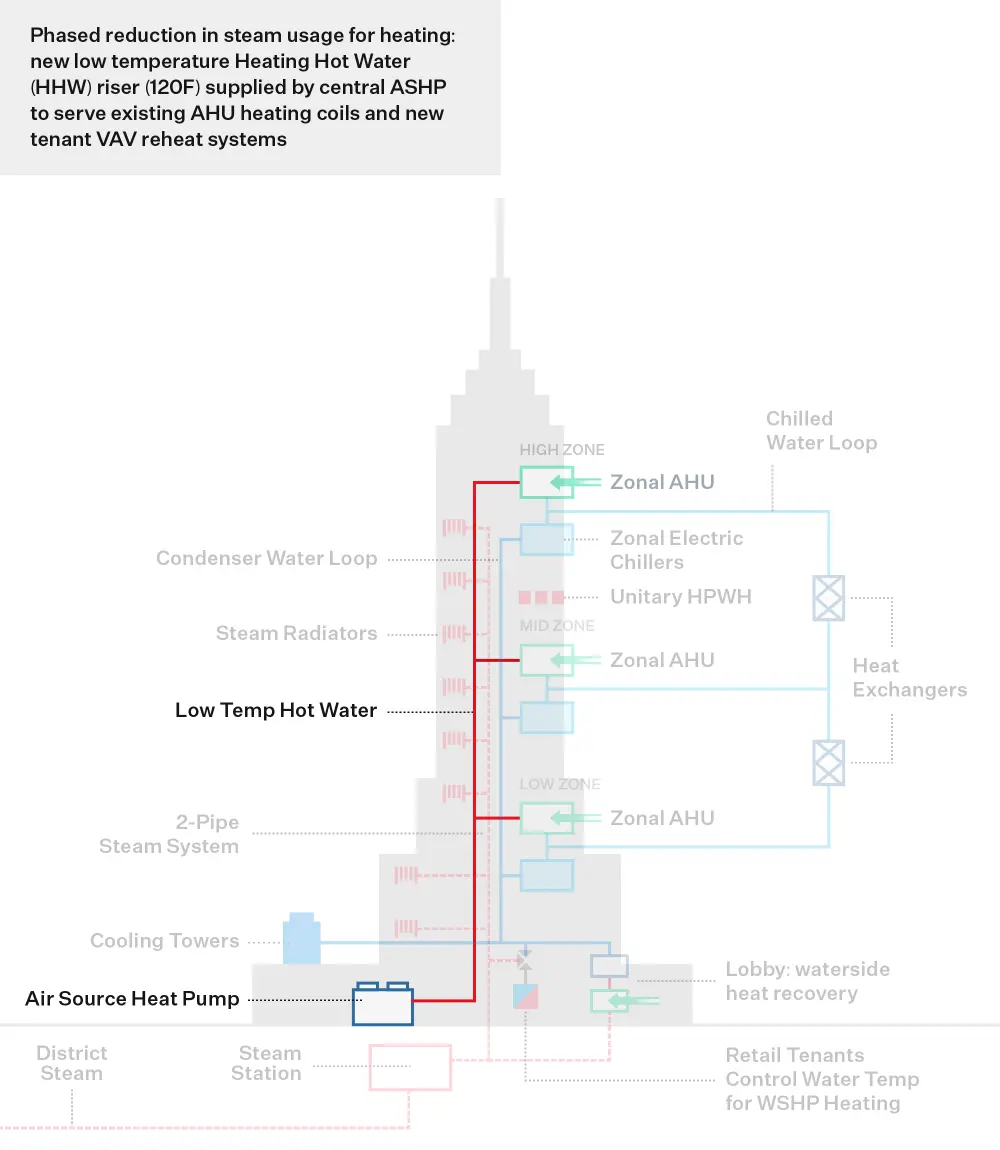
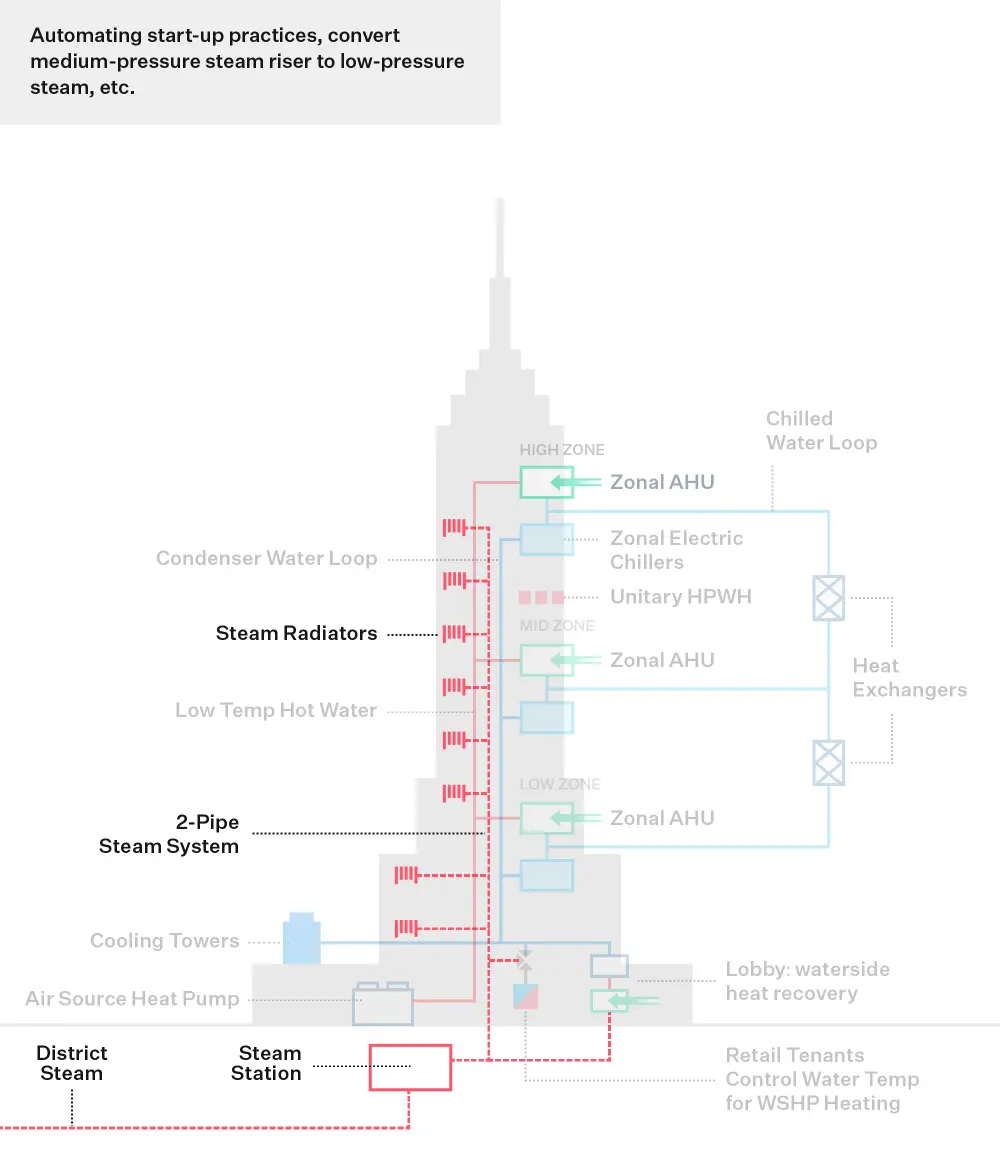
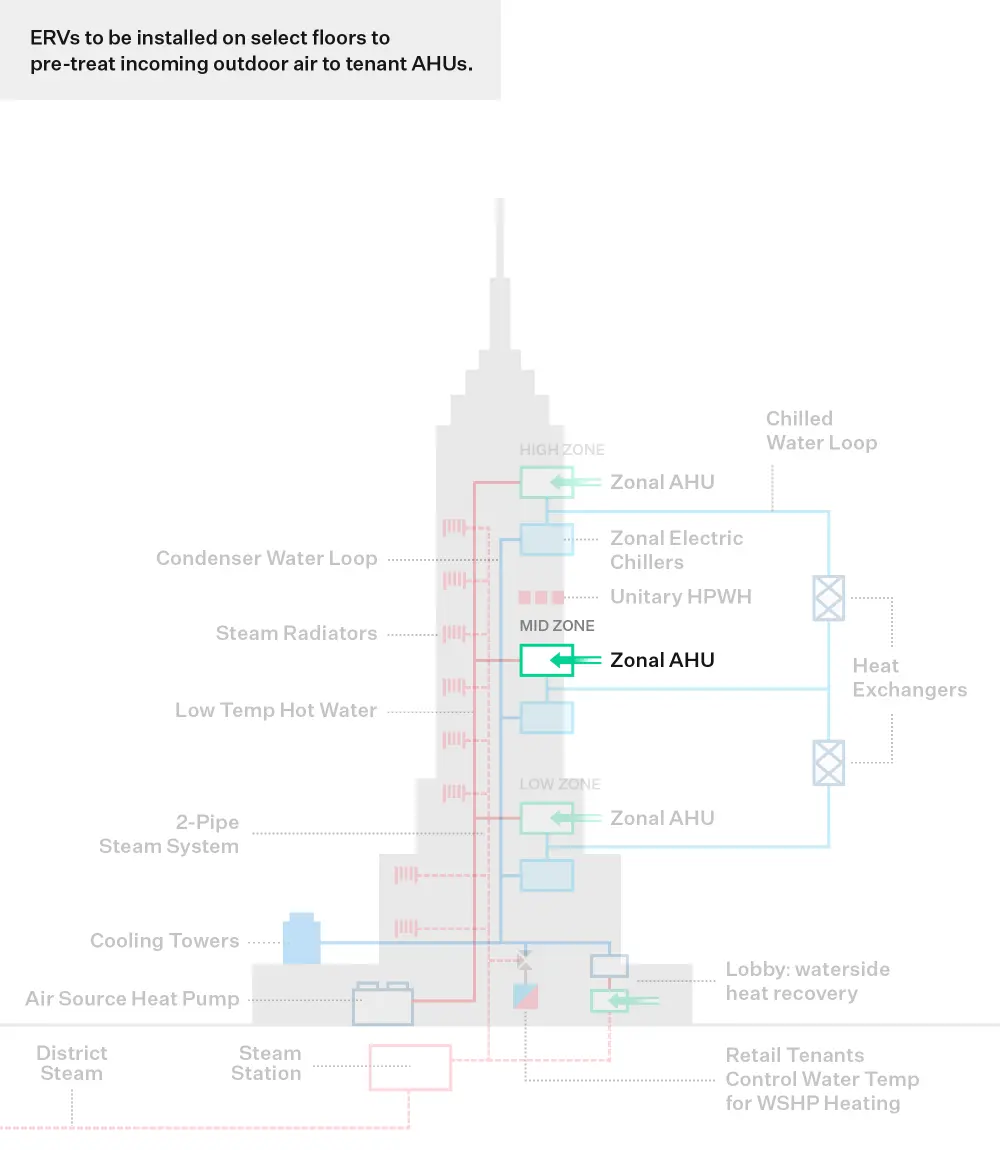
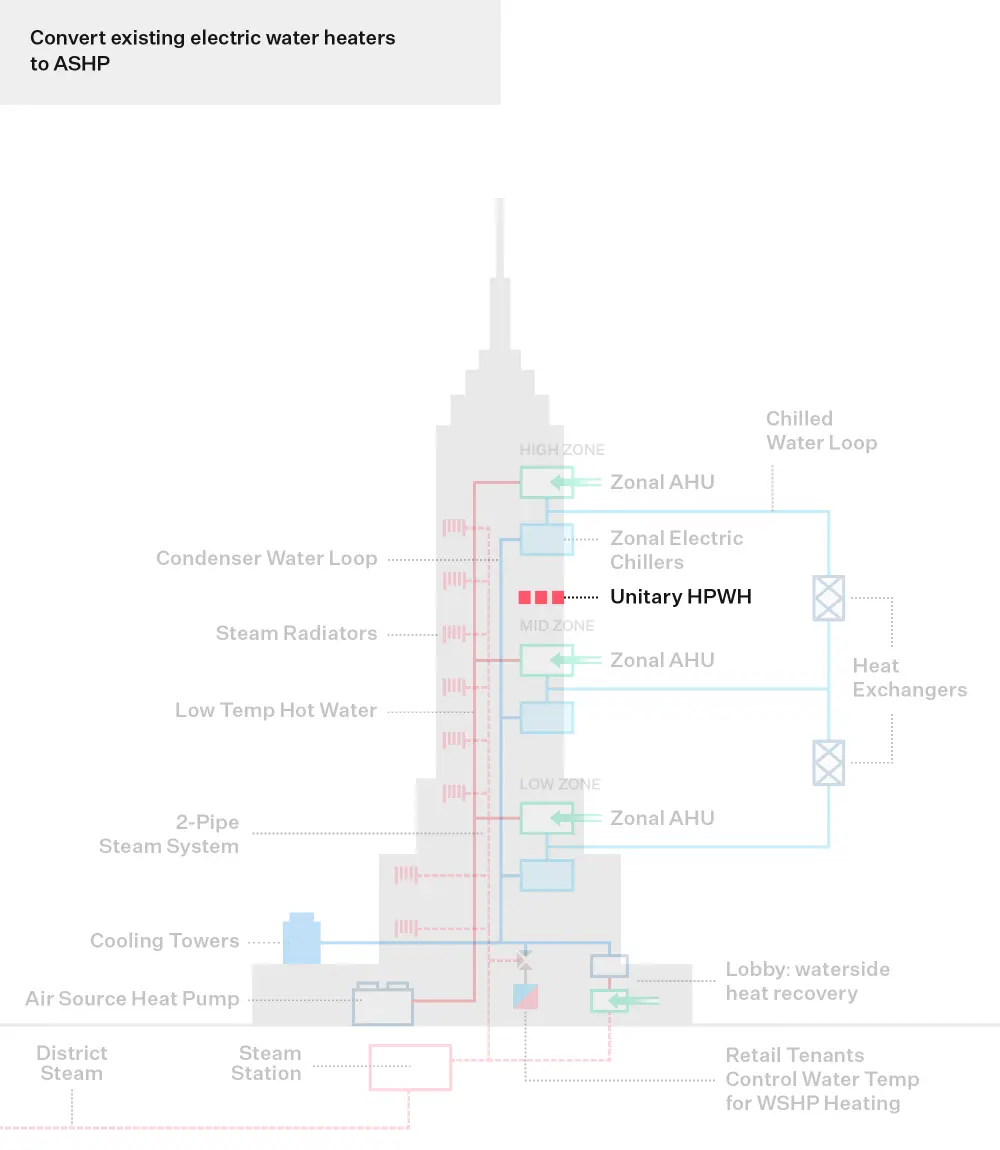
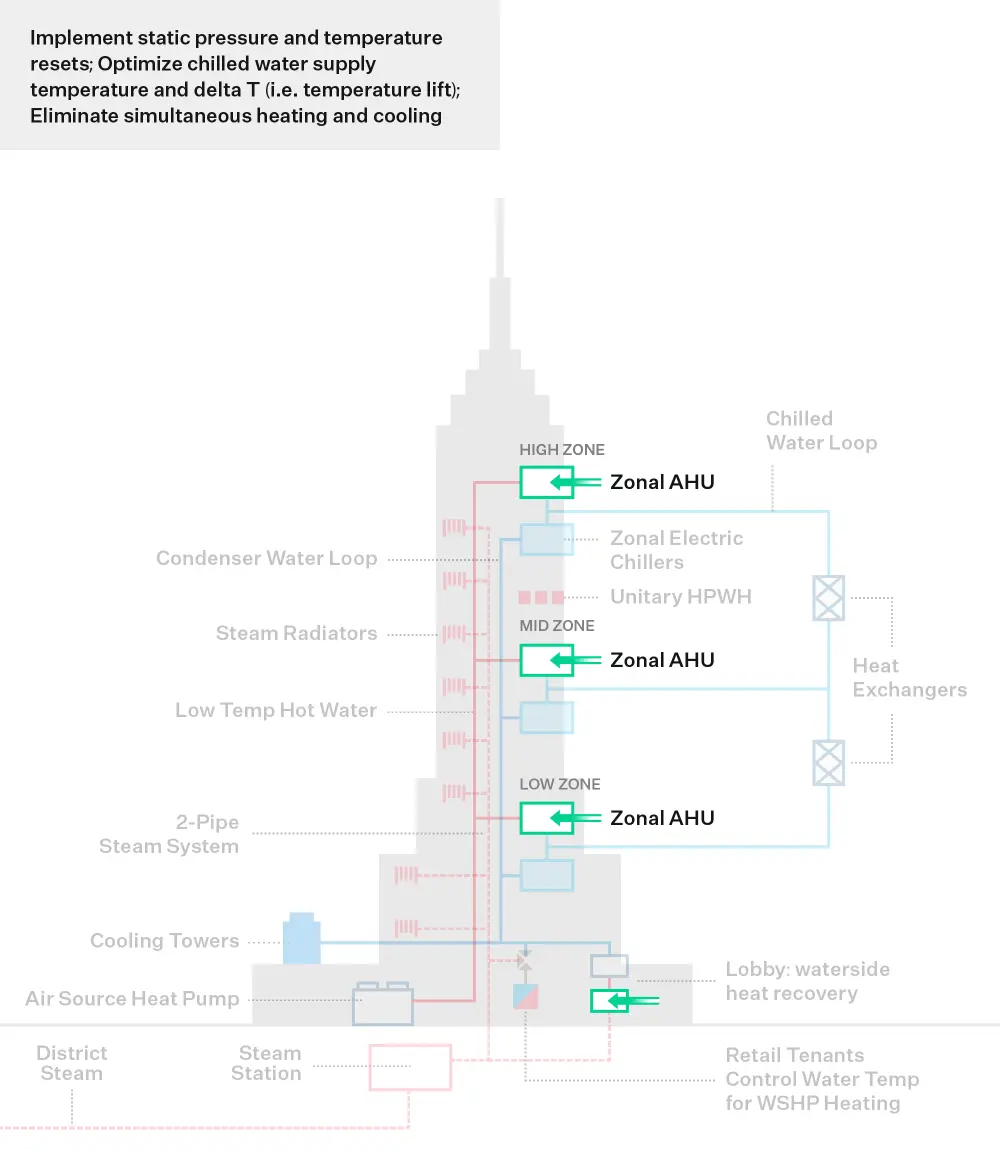
The Empire State Building (ESB) energy model has been developed over the past 15 years. Each year, the energy model has been calibrated based on several factors including utility bills, hourly sub-metering, occupancy rates, new construction projects, etc. The energy usage breakdown showed that space heating, broadcast, and tenant loads were the largest contributors to energy usage. This analysis allowed the team to determine where there were the most impactful opportunities for improvement.
The team narrowed down over 200 energy and carbon conservation measures (ECMs) to 60 that have potential to be implemented over the next 15 years. Each ECM was vetted to ensure technical feasibility and to determine its capacity to reduce energy consumption and further decarbonize the building. The energy modeler analyzed the ECMs through the baseline energy model to extract the associated energy, carbon, and cost savings.
To facilitate a comprehensive comparative analysis, the ECMs were organized into five distinct packages. These packages were designed to include varying combinations and quantities of ECMs, enabling the team to examine their collective impact on carbon dioxide (CO2) reduction and Net Present Value (NPV). This strategic grouping allowed for an in-depth comparison of how different ECM assortments align with the project’s goals, offering insights into the most effective strategies for achieving substantial environmental and financial benefits. ESRT is in the process of installing phased, central heat pump systems in multiple buildings, including the Empire State Building, which will begin to reduce steam consumption at these properties. Pilots of energy recovery ventilators on office systems are underway across the portfolio to reduce energy consumption associated with ventilation and mitigate freeze risks. Installation of hydronic heat recovery systems at ESB, including steam condensate recovery, and a new water-to-water heat pump to recover waste energy and reduce steam consumption.
Project Reflections:
- Consistent rollout of high-performance standards is crucial. Key internal and external service providers (fit out designers, controls vendors, maintenance contractors, lease negotiators) require technical oversight to ensure all their work supports energy and carbon efficiency goals.
- Small deviations of tenant designs from energy code and tenant design guidelines can build up to significant impediments to achieving carbon savings.
- Small decisions add up to big impact. Consider long-term ROI and operational consequences of first-cost decisions on all projects.
- Central systems may present more opportunities for optimization based on automation and controls sequences.
- Capture low hanging fruit – retro-commission & optimize controls for existing systems to eliminate waste energy, increase automation and improve part load efficiencies
- Exploit opportunities for heat recovery (e.g. ERVs, WWHPs, HXs). This mitigates the impact of electrification on peak electrical demand
- Develop electrification pathway – even partial electrification can yield significant carbon reductions
Step 3
Step 3: Build the Business Case
Making a business case for strategic decarbonization requires thinking beyond a traditional energy audit approach or simple payback analysis. It assesses business-as-usual costs and risks against the costs and added value of phased decarbonization investments in the long-term.
Strategic Decarbonization Action Plan
An emissions decarbonization roadmap helps building owners visualize their future emissions reductions by outlining the CO2 reductions from selected energy conservation measures. This roadmap is designed with a phased approach, considering a 20- or 30-year timeline, and incorporates the evolving benefits of grid decarbonization, ensuring a comprehensive view of long-term environmental impact.
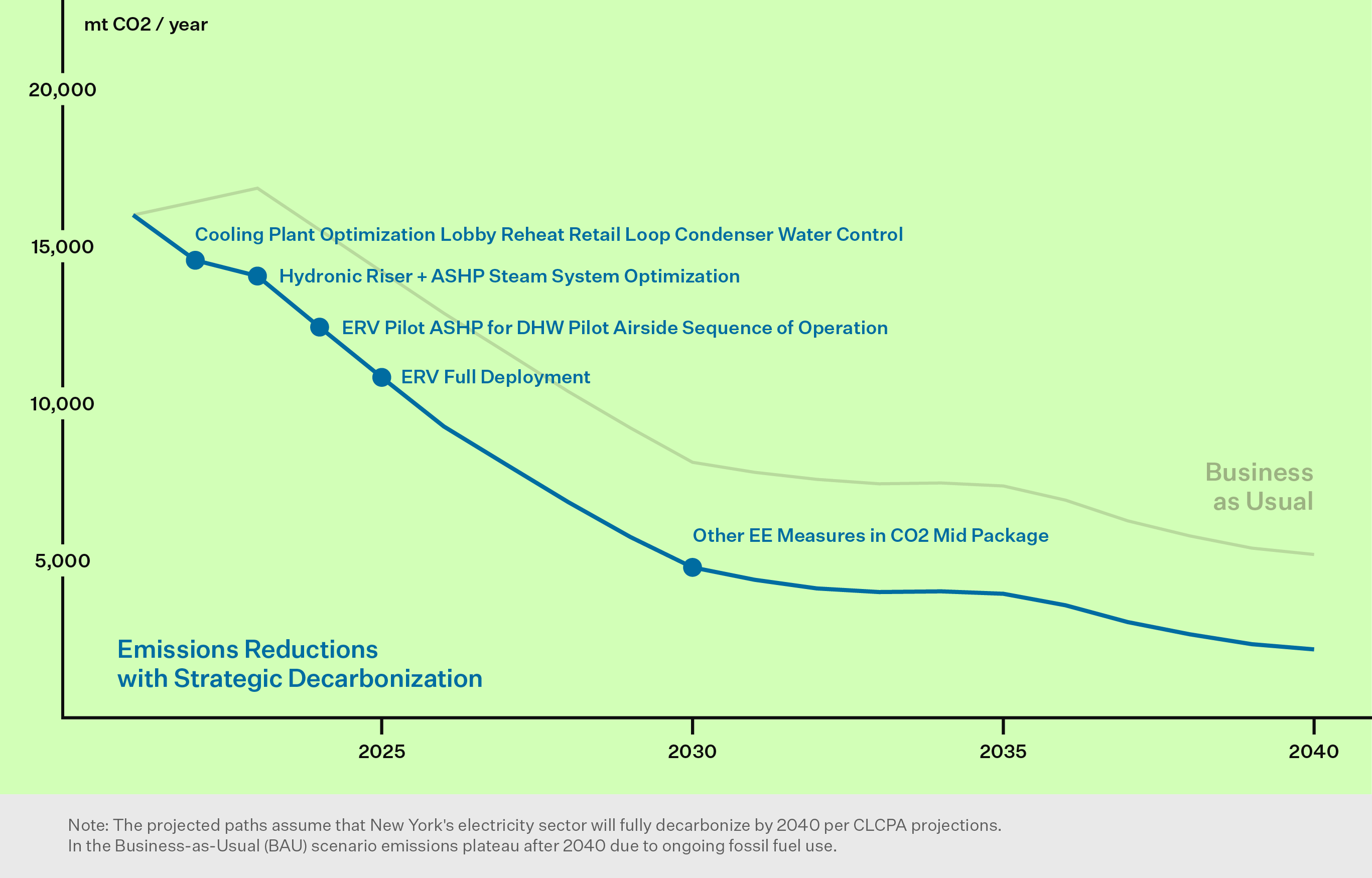
While energy modeling was completed for all 5 packages of ECMs studied, the CO2 Mid Reduction Package was selected to form the Decarbonization Roadmap for the Empire State Building. This package strikes the best techno-economic balance and is in the process of being implemented. Nevertheless, certain ECMs from the CO2 High Reduction Package are highlighted for in-depth evaluation to ascertain their feasibility, cost-effectiveness, and performance metrics. Based on the results from upcoming pilot studies, these ECMs may be integrated into the long-term decarbonization strategy if they prove viable. Both the CO2 Mid and High Reduction Packages align with the Empire State Realty Trust’s (ESRT) objective to achieve an 80% reduction in carbon emissions by 2030, relative to the 2007 levels, and to comply with the medium and long-term emissions thresholds set by Local Law 97 (LL97) by 2035.
A phased approach that strategically deploys energy conservation measures over the next 15 years can deliver an additional 14.5% reduction in annual building CO2 emissions, with a simple payback of 6.8 years. By the conclusion of the 15-year analysis period, projections indicate that the CO2 Mid Reduction Package will achieve a 64.8% reduction in energy use compared to the 2007 baseline, significantly contributing to the building’s sustainability goals. The most substantial energy savings within this package are anticipated to arise from Phases 1, 2, and 5, with steam phase-out highlighted as a separate component due to its significant impact. These phases are expected to contribute energy savings of 6.1%, 8.0%, and 5.7% respectively, underscoring their critical role in the building’s comprehensive energy reduction strategy.
